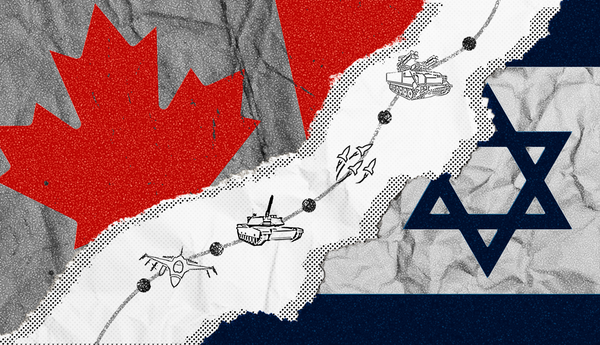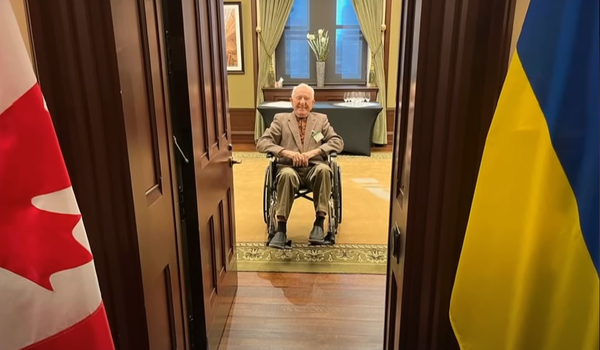A year ago, palliative care physician Dr. Amit Arya and disability justice advocate Megan Linton gave a dire warning about Ontario’s future as the Doug Ford government lifted mask mandates: We’re not ready.
At the time, they explained to The Maple that decades of austerity and privatization left the province short of the crucial infrastructure required to handle the impending wave of acute and long COVID infections.
Meanwhile, the government’s downloading of responsibility to individuals meant Ontarians, particularly vulnerable populations, would be at severe risk. The ensuing crisis could then pave the way for further privatization of health services.
“This strategy is not about learning to live with COVID, but rather about surrendering to it,” said Arya this time last year. In the same article, he predicted the surge in cases would have a “disastrous effect” wherein people would be left “waiting on life-saving essential surgeries."
This grim scenario appears to be coming true. The most recent numbers show that surgical waiting list deaths are up 24 per cent over the last four years, according to the advocacy group SecondStreet, with over 13,000 Canadians dying in 2022 while waiting for surgeries and routine procedures, like MRIs and CT scans. 2022 was the deadliest year for COVID-19 in Canada, with over 19,000 killed by the disease.
According to Arya, this made COVID the third-leading cause of death nationwide, behind all combined forms of heart disease, and all combined forms of cancer. Amid this strain on the health system, the Ford government has pushed ahead with privatization efforts, including an immediate plan to ramp up the number of surgeries performed at for-profit clinics.
Unions immediately criticized the plan, pledging a “campaign of resistance” to the measures. CUPE president Fred Hahn said in a statement in January: “[Ford’s] government has starved our hospitals of funding and created a staffing crisis by keeping wages low, a choice that affected women workers in particular.”
“If you're a patient receiving chronic care right now, you're not able to get emergency care, you don't have access to urgent care, you don't have access to the testing or the surgeries that you require,” said Linton, who is a researcher with Disability Justice Network Ontario and herself requires chronic care for her disability. “They'll send you home if you are on the verge of complete medical breakdown, and it's killing people.”
While many Ontarians might assume that the province in ordinary times has an equitable healthcare system, Linton said the current crisis is not unprecedented, nor surprising.
“The media … can do a really good job of talking to doctors and the medical community about this crisis,” she explained. “But on the patient end, and the sick person side of things, people don't understand the severity of what's happening.”
According to Arya, that severity cannot be stressed enough. “We're ignoring COVID as it continues to cause mass disability, suffering and death,” he explained. Beyond the disturbing number of deaths are cases of long COVID, which could impact as many as 15 per cent of Canadian COVID sufferers, according to a Statistics Canada survey.
“There are many horrific stories of people suffering from long COVID who now cannot afford to live, because they lost their job and can’t afford rent,” said Arya.
He said these stories stay largely under the public radar because long COVID is so poorly studied, and governments don’t want to acknowledge the potential scale of this crisis. Arya foresees a future where the “legislated poverty” of the Ontario Disability Support Program (ODSP) becomes a widespread norm, with domino effects on the economy.
To Arya, much of the current crisis can be traced to the Ford government’s refusal to take public or collective responsibility for the spread and management of COVID-19. Instead, Arya said, the Ford government downloaded responsibility onto individuals, with predictable results.
“If you're someone who's living with long COVID, somebody immunocompromised, or you’re living with a disability, or you're a caregiver, it really feels like you're on your own now,” said Arya. “And if you're sick, it's ‘your fault.’”
“It should primarily be the responsibility of governments and public health to deal with this virus, not of high-risk individuals,” he continued. “In fact, I would say that it’s profoundly ableist to tell people that they have to take precautions … while the rest of society enjoys their so-called freedoms.”
Arya stressed just how avoidable this crisis was, and how fixable it remains today.
He pointed to the Cholera pandemic that ravaged much of the world from 1826-37, killing hundreds of thousands of people.
This led to increased scientific and public awareness of contagious diseases. In response, governments began upgrading sewage and water treatment infrastructure in densely populated areas. Today, Cholera affects only the most impoverished and under-served areas of the world.
Given that we know exactly how COVID spreads through the air, said Arya, “we could upgrade ventilation and filtration in places like schools, workplaces, and healthcare settings” as an obvious and relatively simple first step. “Of course, it would require government investment, but it would dramatically reduce transmission of COVID-19 and keep people safe."
This wouldn’t just reduce the number of acute COVID cases, and therefore the strain on our emergency rooms and urgent care centres. It would also avert a potential catastrophe of mass disability. “The best way to prevent long COVID is to prevent short COVID,” said Arya.
Arya is not the only healthcare professional to emphasize these concerns, and the research he cites is the same research that Canada’s governments, at all levels, have access to.
However, Ford’s government has left hospitals understaffed and underfunded, refusing to properly hire or compensate nurses at a time when demand on the system is highest.
“For disabled people, we know that this has been the reality of our healthcare system for so long,” said Linton. She pointed to the rapid privatization of publicly run long-term care institutions in the 1990s, many of which were replaced by the for-profit centres that exist today and which became focal points of scandalous stories of neglect during the pandemic first wave.
“Neoliberalism … has killed so many people,” said Linton. “A lot of disabled people have known this for decades, and we’ve been waiting on (able-bodied people) to clue in.”
She also noted that Canada has been lagging behind on the metric of hospital beds per 1,000 people since the 1980s, and was the eighth worst out of all OECD countries heading into the pandemic.
Likewise, Canada’s patchwork systems for dentistry, optometry, medication and mental health have forced many working-class Canadians to pay out of pocket, or to go without crucial and sometimes life-saving healthcare.
Linton said there is also a misconception that these policies are unique to Conservative governments, when in reality virtually every province is experiencing some form of healthcare crisis: British Columbia’s NDP government, for example, has been facing emergency room closures in its rural communities.
According to disability researcher and theorist Beatrice Adler-Bolton, this hierarchy of health is by design.
“Under capitalism, the people who don't measure up to the neoliberal ideal of perfect efficiency are treated as disposable,” said Adler-Bolton, who is also co-host of the podcast Death Panel and co-author of Health Communism.
This section of the working class is called a “surplus population” or those who are rendered unable to generate capital – whether it be through disability, or social factors like single parenting – and so are alienated from the basic benefits of capitalism.
“We all know people in our lives who we love and value but are not valued by the state,” she explained. “Instead they’re treated as a waste or a burden … it's difficult to watch.”
Despite capitalism’s treatment of those populations as disposable, said Adler-Bolton, surplus populations are integral to our healthcare systems and broader economy under capitalism. The for-profit medical industry can only function if it has a consistent supply of patients in need of its products and services, and chronically ill and disabled people are those companies’ number one returning customers.
Arya, Adler-Bolton and Linton all agree that Doug Ford’s privatization will see public healthcare in Ontario deteriorate further and open even more opportunities for private companies to exploit.
“There is a large and growing body of data and evidence that tells us for-profit healthcare leads to worse quality, and actually comes at a higher cost for the taxpayer,” said Arya.
Living with a disability in America, Adler-Bolton said she has seen firsthand the devastating effects this can have on working class and surplus populations.
“(I’ve seen) people end up with stage four cancer because they delay primary care for so long, because they're overburdened by other medical bills,” she said. Adler-Bolton also pointed to Moderna’s decision to consider raising the price of its mRNA vaccine in the U.S. as soon as President Joe Biden announced plans to privatize his government’s vaccination program.
“They’re expecting sales to go down,” explained Adler-Bolton. “So everyone knows: you privatize it, you get less usage.”
Back in Ontario, the situation looks set to deteriorate further. The province’s Financial Accountability Office recently revealed that Ford’s government is slashing hospital capacity by spending $21 billion less on healthcare.
Meanwhile, the federal government announced it is clawing back $82.5 million in federal health transfers from seven provinces that allowed private companies to charge for diagnostic services, including through virtual care appointments.
“I think it's shameful that the (provincial) government can't take basic care of its people,” said Linton. “But (the federal announcement) is a good step.”
Arya said another alarming aspect of the current situation is the chaos of Ford’s hyper-individualized approach, which makes it difficult to create models or reliably track the impact of the crisis on populations. This in turn affects public health authorities’ abilities to measure, predict and prepare for surges or new disease strains.
“Public health is making decisions influenced by politics, rather than influenced by science and health equity for vulnerable populations,” Arya added. “It’s hard to predict exactly what will happen … but I really worry that things aren't going to get better.”
Cassandra Kislenko is a non-binary settler journalist working and writing on Treaty 13 territory in Tkaronto. Follow her on Instagram and Twitter.
Go deeper
Here are a few stories from our archive that expand on today's story
How For-Profit Corporations Expanded In B.C.’s Long-Term Care Sector
Recent conversations around health care privatization in Canada have focused on corporate creep into aspects of health care that are typically covered under the Canada Health Act (CHA), like primary care clinics. But private interests have spent decades moving into areas of health care that fall outside the CHA, such as long-term care.
Here’s What Health Professionals Say About Doug Ford’s Plan to Privatize Surgeries
Ontario Premier Doug Ford announced plans to further privatize surgical and other medical procedures, meaning more of those services will be delivered by for-profit health facilities.
Top Maple story this week
Podcast: Why Bill C-18 Won't Save Canadian Journalism

On the latest episode of The Maple's North Untapped podcast, we spoke to Dru Oja Jay from The Breach about why Bill C-18 will likely end up subsidizing the profits and debt repayments of corporate media giants like Postmedia, and why the government should instead focus on providing such revenues to non-profit news organizations dedicated to public-interest journalism.
Download the full episode for free on Apple, Spotify or Google.

Catch up on our latest stories
- When International Women's Day Organizers Protested Ronald Reagan's Visit to Canada.
- From The Readers: Better Wages Versus Tips.
- Photo of Toronto Officer Holding Assault Weapon Highlights Increasing Militarization of City's Police.






